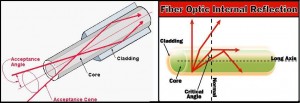FIBER OPTICS
What is Fiber Optics:
Data is of no use if the storage and transmission is not proper, transmission of Data is the main concern behind every Security System. An administrator can access and control his/her system from a long distance across seas. The long distance data transmission requires a special channel. One of the long distance vectors for data/signal is Fiber Optic Technology. An optical fiber consists of a light-transmitting core fiber embedded in a glass cladding and an external plastic cladding.
Principle:
When light hits the boundary layer in a small angle of incidence, the different densities of the core and the glass cladding cause total reflection. The light beam is reflected almost free of any loss and transmitted within the core fiber only. The diameter of an optical fiber is approx. 0.1 mm. Depending on the version, the diameter of the light-transmitting core lies between 9 µm and 60 µm. Usually, several up to a thousand of such fibers and a strain relief are grouped into a cable. The light signals are usually supplied to the fiber via a laser LED and analyzed by photo-sensitive semiconductors on the receiver side.
Advantage:
1. Signals transmitted in optical fibers are resistant to electromagnetic interferences.
2. Slightly attenuated, i.e- less decrease in the intensity of the signal.
3. Can achieve high data rates.
4. Suitable for extremely high data rates and very long distances.
5. Resistant to electromagnetic interference.
6. No electromagnetic radiation.
7. Suitable for hazardous environments.
8. Electrical isolation between the transmitter and receiver stations.
For high data rates and large transmission distances, excellent repeat accuracy of the light pulses during transmission is mandatory. Therefore, the optimum transmitter should be a light source with a spectral bandwidth (laser) that is as small as possible and with extremely small core fibers. Two different fiber types are available, multimode and monomode fibers.
Monomode fibers help achieve the best pulse repeat accuracy. The core diameter of these fibers is so small that only the paraxial light beam can be formed. The small diameter, however, requires particularly high precision when the light beam is supplied to the fiber.
If multimode fibers with a larger diameter are used, the number of possible propagation paths increases and, hence, the distortion of the pulses. However, this effect can be reduced by using specially manufactured fibers. These special fibers do not have a step index profile, i.e. a constant refractive index, but a so-called grade index profile. In this case, the refractive index of the core increases with the radius. The propagation rate which changes with the refractive index largely compensates for the different propagation times in the core, thus enabling higher pulse accuracy.
The handling of optical fibers, i.e. cutting to length and termination, as well as coupling and decoupling of optical signals is comparably complex and therefore expensive. These are the reasons why fiber optics are only used when great distances must be covered at high data rates, or else when special EMC measures must be taken.








